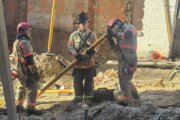WASHINGTON — Nobody likes getting stung by a bee, but when a honeybee flew up a graduate student’s shorts and stung him in the testicles, it made him wonder: Where is the most painful place to get stung?
Michael Smith, who studies the behavior and evolution of honeybees at Cornell University, subjected himself to hundreds of bee stings in an attempt to determine the body parts where bee stings hurt the most or least.
Smith’s conclusion: The three most painful places to get stung are the nostril, the upper lip, and the penis shaft.
The least painful places? The skull, the tip of the middle toe and the upper arm.
Smith administered five stings a day, grabbing a bee by its wings with forceps, and pressing it into the body part he was testing.
Choosing a sting to the forearm as average pain, Smith began and finished each session there.
“I would sting myself on the forearm, rate that pain as a 5, then use the experimental stings to see if those were more painful or less painful than a sting to the forearm,” says Smith.
By ending with another sting on the forearm, Smith reconsidered the ratings he had given the three other test sites.
Smith’s paper, “Honey Bee Sting Pain Index by Body Location,” was published in the scientific journal PeerJ.
Somewhere between not bad and excruciating
Getting stung on the skull was a snap, ranking 2.3 on Smith’s pain scale.
“I wouldn’t say it was pleasurable, but it definitely wasn’t as painful as I was expecting,” says Smith.
“It was a stinger directly to the top of your head. It felt similar to kind of like having a raw egg smashed on your head and kind of dribbling down your head — a slightly electric egg if you will.”
The most painful place to get stung, earning a 9.0, was the nostril, according to Smith.
“Your whole body reacts when that happens,” says Smith. “You’re sneezing, your eyes are watering, a lot of mucus is flowing out of your nose, it’s a whole-body reaction.”
Number 2 on the the pain list was the upper lip, followed by the penis shaft.
Asked if it was difficult to force a bee to sting him in the crotch, Smith put it into perspective.
“I’d actually say the upper lip was more difficult to administer,” says Smith. “You’re holding a bee with forceps and you’re trying to get her to sting you, and you’re using a mirror and your hands are in the way.”
Here is Smith’s complete list, from least painful to most painful:
| Body location | Pain rating | ||
|---|---|---|---|
| Medical terminology | Layperson terminology | Average rating | Standard deviation |
| Anterior vertex | Skull | 2.3 | 0.6 |
| Third distal phalanges (foot) | Middle toe tip | 2.3 | 0.6 |
| Proximal humerus, dorsal aspect | Upper arm | 2.3 | 0.6 |
| Buttocks | Buttock | 3.7 | 0.6 |
| Dorsal aspect of leg | Calf | 3.7 | 0.6 |
| Posterior trunk, lumbar region | Lower back | 4 | 1.7 |
| Anterior aspect of proximal thigh | Upper thigh | 4.7 | 1.2 |
| Anatomic wrist, ventral aspect | Wrist | 4.7 | 0.6 |
| Foot, plantar surface | Foot arch | 5 | 1.7 |
| Distal arm, dorsal aspect | Forearm | 5 | n.a. |
| Popliteal fossa | Back of the knee | 5 | 1 |
| Posterior neck, cervical region | Back of the neck | 5.3 | 1.2 |
| Postauricular | Behind the ear | 5.3 | 1.2 |
| Hand, dorsal aspect | Top of the hand | 5.3 | 1.2 |
| Foot, dorsal aspect | Top of the foot | 6 | 1 |
| Abdomen | Abdomen | 6.7 | 0.6 |
| Third distal phalanges | Middle finger tip | 6.7 | 0.6 |
| Nipple | Nipple | 6.7 | 0.6 |
| Axilla | Armpit | 7 | 0 |
| Buccal aspect of face | Cheek | 7 | 0 |
| Hand, anterior aspect | Palm | 7 | 0 |
| Scrotum | Scrotum | 7 | 0 |
| Body of penis, dorsal aspect | Penis shaft | 7.3 | 0.6 |
| Tubercle of superior lip | Upper lip | 8.7 | 0.6 |
| Anterior nares | Nostril | 9 | 0 |







